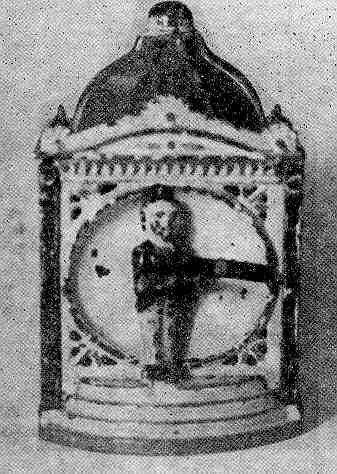Hall's Liliput Bank (Type I)
by F.H. Griffith - HOBBIES Magazine - November, 1973
 An apparently tough little bank to
obtain is our choice as No. 229 in the numerical classification. This is Hall's Liliput
Type I, and as with the New Bank Type I, the writer, until fairly recent years, did not
really realize the scarcity of the Liliput Type I. Surely the Liliput Type III with the
tray is one of the more common mechanicals and well known by practically every mechanical
bank collector. This is not the case with the bank we know as Type I.
An apparently tough little bank to
obtain is our choice as No. 229 in the numerical classification. This is Hall's Liliput
Type I, and as with the New Bank Type I, the writer, until fairly recent years, did not
really realize the scarcity of the Liliput Type I. Surely the Liliput Type III with the
tray is one of the more common mechanicals and well known by practically every mechanical
bank collector. This is not the case with the bank we know as Type I.
John Hall of Watertown, Mass., one of the better known and early designers of mechanical banks, is responsible for the Liliput Type I. He covered the bank by a regular patent May 4, 1875. The drawings with this patent are not too representative of the bank as it was actually produced. However, Mr. Hall was awarded a design patent on the bank July 27, 1875, and this is exactly like the bank itself. Unusual is the fact that the illustration of the Type I used in this patent is an actual photograph instead of the usual drawing. The J. & E. Stevens Company, Cromwell, Conn., manufactured the Liliput, as well as other banks designed by Hall, such as the Horse Race and Hall's Excelsior.
The bank pictured is in quite nice original condition, particularly so for such an early item. That is to say all evidence indicates that it was not made for many years, reasons for which we will point out. Therefore, examples of the Type I were necessarily made in the middle and late 1870's.
There are many differences between Type I and Type III Liliputs. Outstanding is the lack of a tray in the figure's hands, the Type I simply having the coin rest on the extended arms of the figure. Actually the bank does not operate as well as the Type III with the tray. This is one of the reasons for the changeover. Next is the fact the bank is held together by force. That is to say a lug on the top of each sideplate fits into a slot on each side of the roof and two bottom lugs on each of the sides fit into respective slots in the base plate. These lugs snapped into place when the bank was assembled by forcing the lugs into their respective slots. In so doing considerable breakage occurred and the example pictured, as well as the few others the writer has seen, all have a crack or two which occurred at the time of assembly at Stevens. This is another reason for the change to Type III. The sideplates, by the way, hold the front and back of the building in place. As to other differences, the entire building is narrower and there are no perforations in the oval section in back of the figure. The left sideplate has the name "Hall's Liliput Bank" in circular form, the right side has "Patented May 1875 & January 1876" also in circular fashion. On the backplate appears "Pat. Design, July 27, 1875." The January 1876 patent date shown on the bank is for Patent Number 172,016, January 11, 1876. This patent covered the "Method of securing together the various parts. A toy money bank consisting of bottom, sides and top, secured together by means of the lugs or clasps."
As to coloring, the bank is an overall light blue-green. The dome roof is a brick red with yellow top knob. Decorations on the front are in dark brown and brick red. The steps are tan and the oval section back of the figure is a very light blue-white. The figure's face is a light pink flesh color with a black definition of eyes, eyebrows, and moustache. His hair is also black, as is his jacket. He has gray trousers and brick red shirt. Lettering on the sideplates is in the same red. That color was also used around the base plate, completing the colors of the bank.
John Hall would seem to have been engrossed with the idea that the weight of a coin must cause the action of the bank, and his Liliput is no exception. On placing a coin on the extended arms of the figure the man turns to his left dropping the coin into the provided slot. He returns automatically to position as shown in the picture.
The writer cannot help but admit that he agrees with Hall's apparent philosophy with respect to the necessity of the use of a coin in causing the action. In other words, while we wouldn't necessarily want all mechanical banks to operate on this basis, nevertheless those banks that do not operate properly unless a coin is used certainly have added interest.
